MOBILE VETERINARY



SWT/KWS MERU
UNIT JULY 2022
Introduction
Cases in July
July Report by Dr. Aminga Duncan
2 HWC Cases
2 Rhino Cases
Strong winds and a drop in ambient temperature were experienced in July. Despite the continued dry spell, the permanent rivers within the Meru ecosystem continued to provide sufficient water for its wildlife.
During the month, the Meru Mobile Veterinary Unit attended to 7 cases in total. This included 1 poaching case involving a snared reticulated giraffe and 2 white rhino cases involving 4 animals. The 1st rhino case entailed freeing an animal that had a discarded fence wire entangling its hindlimbs while the 2nd case involved the translocation of 3 rhinos from Meru Rhino Sanctuary to Partakilat Wildlife Sanctuary. Other notable cases attended to this month included treatment and relocation of a Grevy’s Zebra stallion after it strayed into an urban centre and treatment of a lioness for bite wounds suffered during a fight
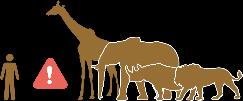
Acknowledgement
The Meru Mobile Veterinary Unit appreciates the funding and ongoing support enjoyed from Sheldrick Wildlife Trust and Sylvie Chantecaille. The support received from other conservation partners and Kenya Wildlife Service (KWS) through the Senior Assistant Director Eastern Conservation Area, and the Head KWS Veterinary Department is also greatly appreciated. We also thank everyone who participated in the various veterinary interventions.
Case Details
Date Species Area Found
13 July 22 White Rhino Meru N.P. HWC
19 July 22 Giraffe Meru N.P. Snared
Reason for Intervention Outcome
Discarded fence wire entangling its hindlimbs. Task successful.
Lame and seen with a wound on its swollen left hindlimb. Treated successfully.
20 July 22 Lion Meru N.P. Natural Causes Bite wounds on the lumbosacral region. Treated successfully.
20 July 22 Zebra Muriri Town HWC
21 July 22 White Rhino Meru Rhino Sanctuary Relocation
Injured and at risk of being slaughtered for meat after it strayed into Muriri town.
Treatment & relocation successful.

Translocation of 3 rhinos from Meru Rhino Sanctuary to Partakilat Wildlife Sanctuary. Task successful.
26 July 22 Giraffe Meru N.P. Natural Causes Appeared to be in pain and had trouble moving about Treated successfully.
28 July 22 Security Dog Meru N.P. Technical Case
Prophylactic treatment of the security dog for trypanosomiasis Task successful.
7
Unit


SWT/KWS Meru Mobile Vet
Treatment Locations July 2022
White Rhino Human Wildlife Conflict
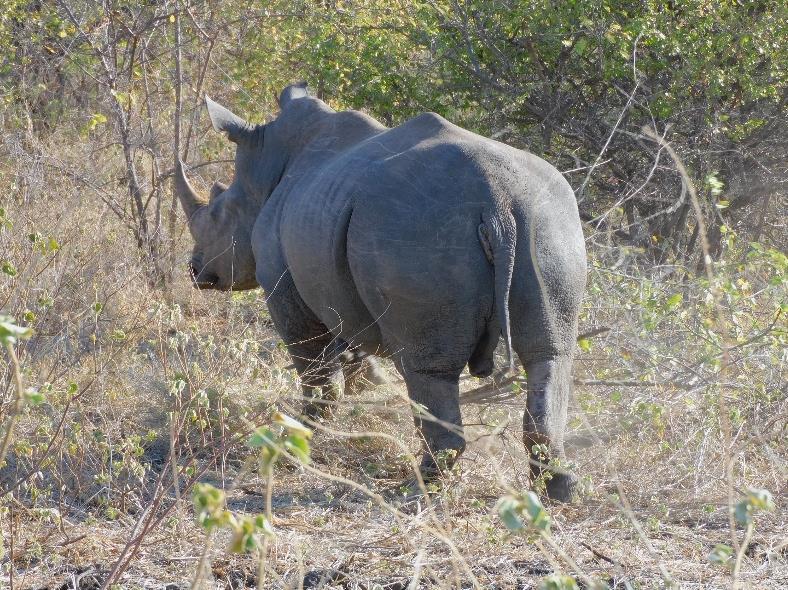
Meru National Park
The Meru Vet Unit was called to attend to a male white rhino with a discarded fence wire entangling his hindlimbs.



Immobilisation, examination and treatment
The rhino was immobilized by darting with 4mg Etorphine and 60mg Azaperone from a Sheldrick Wildlife Trust helicopter This exercise was carried out in collaboration with the SWT/ KWS Mount Kenya Mobile Vet Unit. The animal was manoeuvred by the chopper to an open area and quickly restrained. A blindfold was then placed over his eyes to avoid ocular damage and visual excitation. 25mg Butorphanol was administered intravenously to enhance breathing before a physical examination was carried out It was observed that the loose fence wire had slipped off while the bull was being manoeuvred through the bush to an open area. The wire had not caused any injury. Anaesthesia was reversed with 40 mg Naltrexone administered intravenously and 12 mg Diprenorphine administered intramuscularly to avoid re narcotization. He rose 2 minutes later and walked away.
Relocation, revival and prognosis
The fence wire did not cause any injury, so the rhino has a good prognosis.
Case 1 13th July 2022
Giraffe Snared Meru National Park
The Meru Veterinary Unit was informed of an adult male giraffe seen with a wound on its swollen hindlimb. Preliminary assessment established that the giraffe was lame.

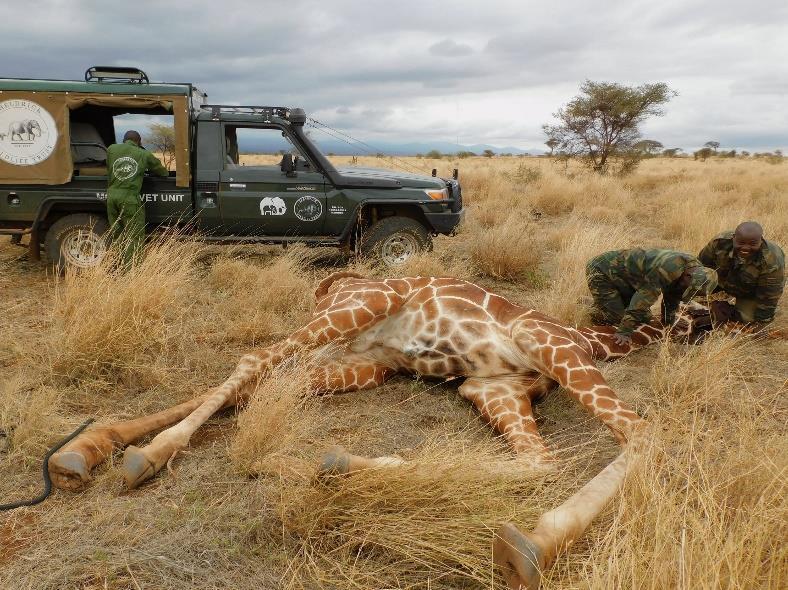


Immobilisation, examination and treatment
The giraffe was darted with 15 mg Etorphine and 40 mg Azaperone on its right rump. He was roped to the ground 6 minutes later after the drugs had taken effect. Anaesthesia was immediately reversed with 48 mg Diprenorphine administered intravenously once he was on the ground then he was physically restrained by pinning the head and neck down. Although the giraffe did not have a snare on his left hindlimb, the wound observed was clearly caused by stricture that is characteristic of wire snares. The swelling was noted to be hard due to the tourniquet effect caused the snare Fortunately, the tissues were still viable. The wound was cleaned and debrided with Hydrogen peroxide then flushed with Iodine and covered with green clay. An antibiotic wound spray was applied to keep off flies and manage bacterial infections. 6,000 mg Amoxicillin, 40 mg Dexamethasone sodium and metabolic stimulators were thereafter administered intramuscularly.
Prognosis
The giraffe has a poor prognosis given the severity of the wound. His recovery will be monitored and follow up treatment carried out.
Case 2 19th July 2022
Lion Natural Causes Meru National Park
The injured lioness was initially seen along Kubai Road in Meru National Park. After searching for 2 days without success, she was spotted on day 3 and tracked by a team from Born Free Foundation.
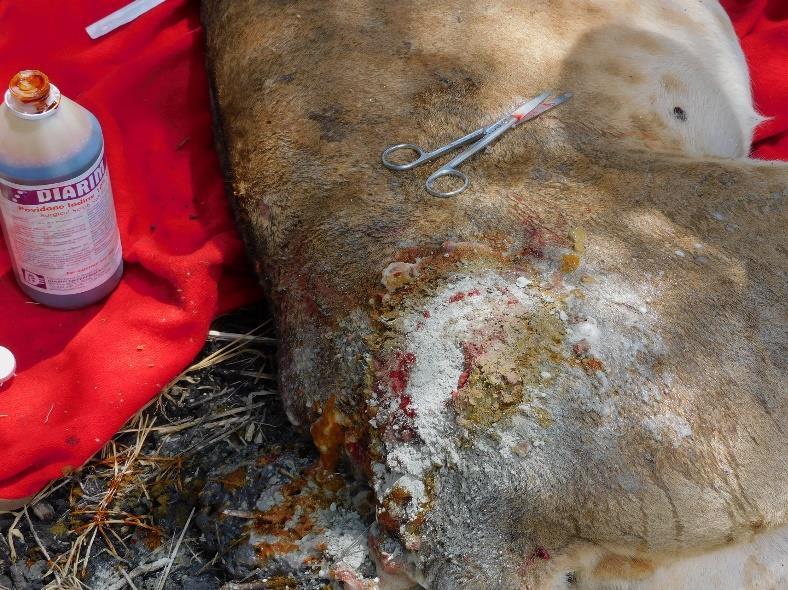


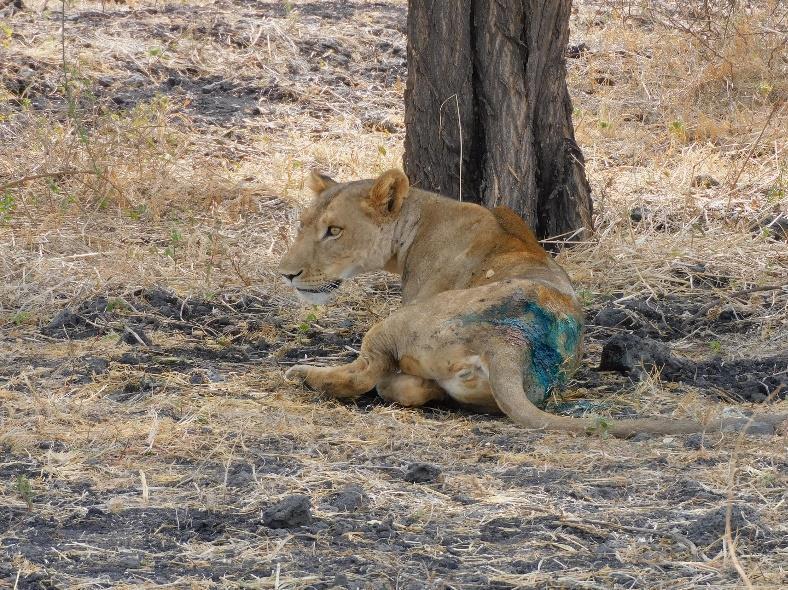
Immobilisation, examination and treatment
The lioness was approached by vehicle and darted on the thigh muscle with 8 mg Medetomidine and 270 mg Ketamine. After the drugs had taken effect, she was secured, blindfold and carried to a shaded area nearby to shield her from the scorching sun. It was observed that she had sustained bite wounds on her lumbosacral region possibly during a fight The spine was examined and found to be intact. The wounds were cleaned, then the skin edges trimmed and debrided with Hydrogen peroxide. Iodine was applied before covering the wounds with green clay and Alamycin spray. 40 mg Dexamethasone sodium and 1,500 mg Amoxicillin was also administered intramuscularly. Anaesthesia was reversed with 32 mg of Atipamezole.
Prognosis
The lion’s
for
Case 3 20th July 2022
prognosis
full recovery is good.
Zebra Human – Wildlife Conflict
Muriri Town
The KWS Meru station notified the Meru Vet Unit that a Grevy’s Zebra stallion was at risk of being slaughtered for meat after it strayed into Muriri town.


Immobilisation, examination and treatment
A team from the KWS Meru station had secured the zebra in a homestead to protect him from a rowdy mob. He was approached furtively on foot and darted on the right rump with 7 mg Etorphine and 70 mg Azaperone. Full immobilization was achieved after 6 minutes in sternal recumbency. There was profuse bleeding from the head (frontal and mandible area) and the dorsal side of his hindlegs where he had sustained deep cuts from machetes. The bleeding was controlled, and the wounds were cleaned then sutured. Antibiotic ointment and alamycin spray were applied on the suture lines to keep off flies. 80 mg Dexamethasone, 6,000 mg Amoxicillin and 20 cc metabolic stimulators were also administered.
Relocation and Prognosis
After treatment, the zebra was loaded onto the bed of a land cruiser and transported to Meru National Park. His respiration was stabilized with 20 mg Butorphanol during translocation. Anaesthesia was reversed with 36 mg Diprenorphine through the Jugular Vein. He rose after 3 minutes and walked away. Follow up monitoring indicated that the stallion was recovering well, his prognosis is good.


Case 4 20th July 2022
Rhino Relocation
Meru Rhino Sanctuary Meru N.P.
The Meru Vet Unit together with a team from the KWS Vet Department carried out the translocation of 3 adult white rhinos (1 male and 2 females) from the Meru Rhino sanctuary to Partakilat Wildlife Sanctuary.



Immobilisation and Relocation
The female rhinos were immobilized with 4mg Etorphine and 60mg Azaperone while the bull was immobilized with 5mg Etorphine and 80mg Azaperone. The animals were darted from a helicopter then manoeuvred to an open area accessible by vehicle.

They were quickly secured, blindfolded then roped for loading into crates. An oxygen cylinder was used for hyperventilation. Anaesthesia was reversed with 25mg Naltrexone administered intravenously and 12mg Diprenorphine administered intramuscularly to avoid re narcotization. 100mg Azaperone was also administered intramuscularly to keep the rhinos calm. Immediately the animals rose, they were directed into crates which were then secured for transportation. The rhinos are expected to adapt well to the new location.
Prognosis
All animals were captured in good health and body condition and therefore have a good prognosis.
Case 5 21st July 2022
Giraffe Natural Causes
Meru National Park
The Meru Vet. Unit was notified of a giraffe bull that appeared to be in pain and had trouble moving about by Mr. Wanjau from the Meru Rhino Sanctuary SWT fence maintenance team.

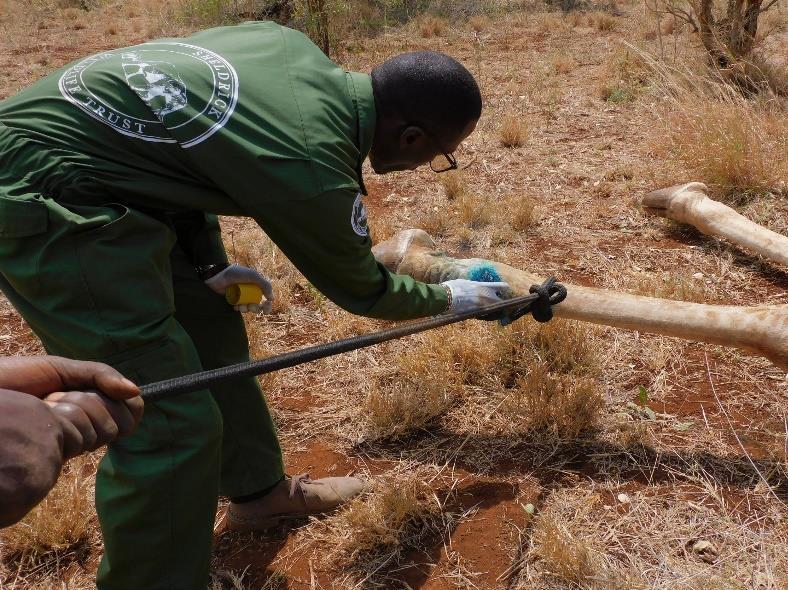

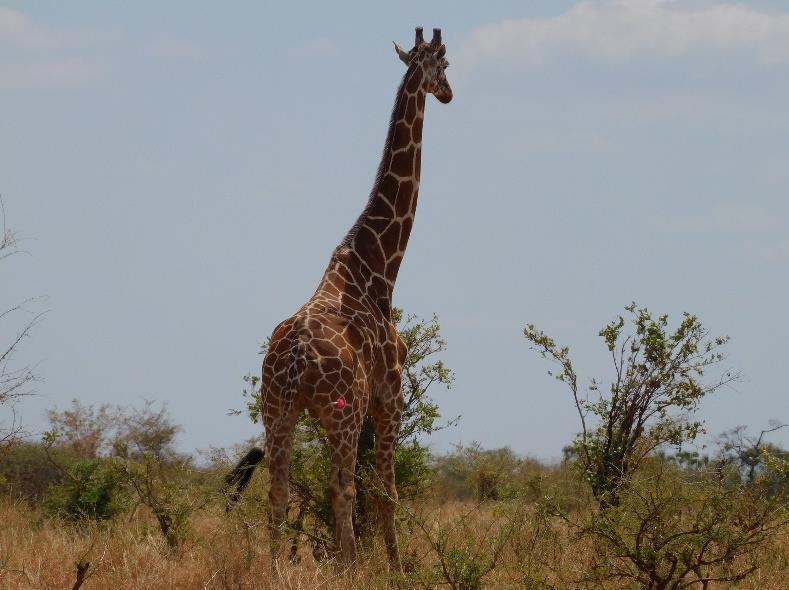
Immobilisation, examination and treatment
The giraffe was found with another male in thick bush. They were slowly herded by vehicle to an open area to facilitate examination and darting. One bull exhibited lameness on its right forelimb. The lame giraffe was darted with 15mg Etorphine and 40mg Azaperone then he was roped to the ground after the drugs had taken effect. Anaesthesia was thereafter reversed with 48mg Diprenorphine administered through the jugular vein. The bull was then physically restrained by pinning his head and neck to the ground. Physical examination revealed a dislocated right shoulder and abrasion wounds at the carpal joint of the same limb. The abrasion wound was cleaned and covered with antibiotic spray. 3,000mg Amoxicillin and 80mg Dexamethasone sodium were then administered parenterally The giraffe walked away after being assisted to stand
Prognosis
The prognosis for his recovery is good.
Case 6 26th July 2022
Security Dog Technical Case
Meru National Park
Canine trypanosomiasis is transmitted by biting flies such as tsetse flies, and the disease can be fatal especially in camels and dogs. It is characterized by anaemia, fever, generalized weakness and staggering gait. Without proper prevention, particularly in disease endemic areas, high mortalities are recorded.
Examination and treatment
The security dog was allowed to familiarize herself with the Vet to avoid excitation. Her weight was measured, and drug dosages calculated based on the recorded weight. A muzzle was put in place, and 0.8 mls Triquin® (Quinapyramine sulphate & Quinapyramine chloride) was injected subcutaneously on the dorsal side of the dog’s neck.
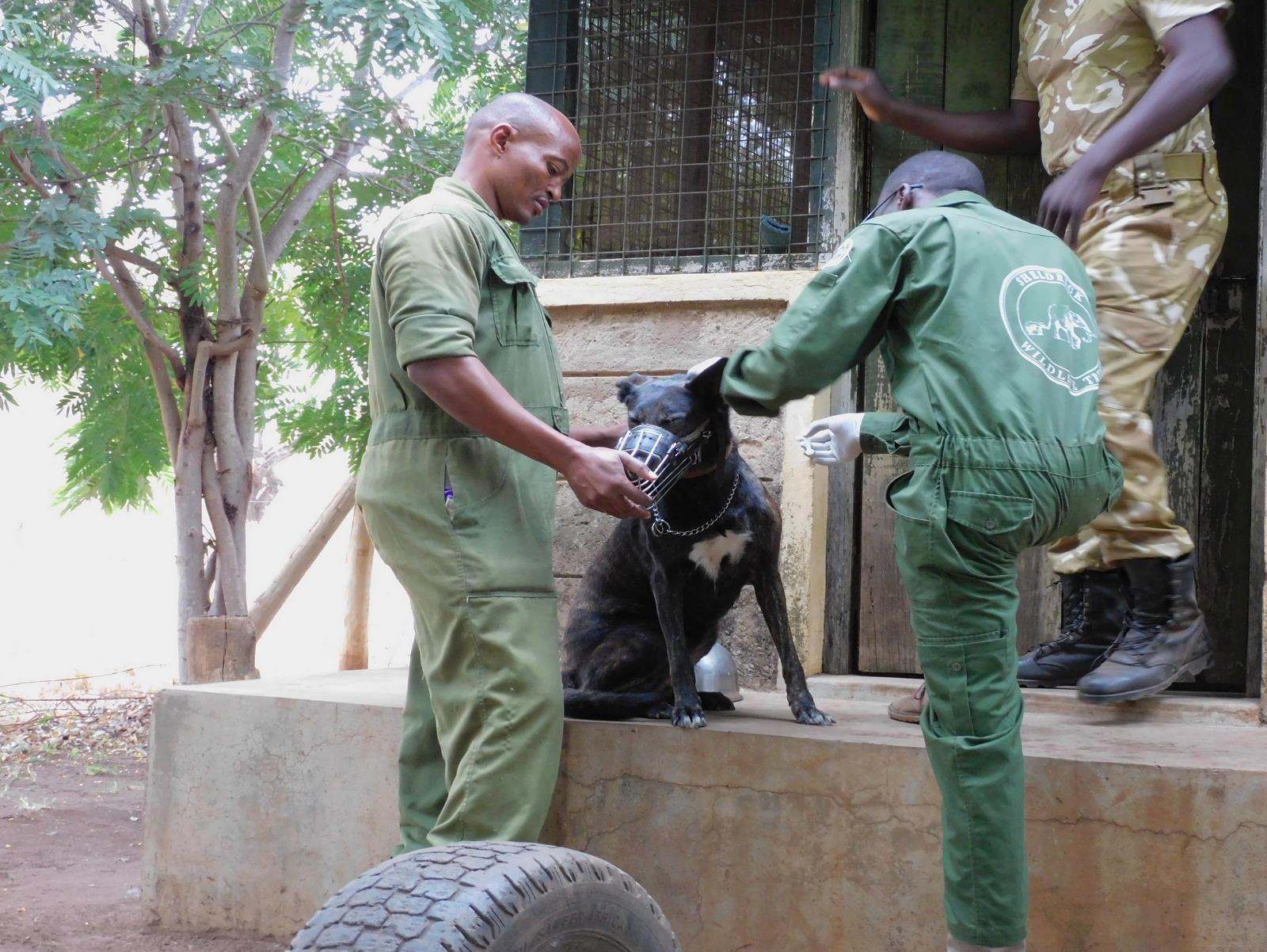
Prognosis
The prognosis is good as no adverse reactions were noted after treatment.
Case 7 28th July 2022
































